-
Posts
512 -
Joined
-
Last visited
Content Type
Profiles
Forums
Gallery
Events
Posts posted by piratepete007
-
-
Thanks to druxey and Dirk for your comments but sorry for the slow reply as I have just flown from the bottom of Australia up to the top (South Australia up to Queensland) and so a bit busy doing home maintenance in my son's house and behind with the texting. In spite of my agreeing with you, Dirk, on the chain not being as long as I have suggested in the diagram, there are examples out there with the chain running right across the stern, notably the HMS Victory ? Just an interesting area to investigate.
Pete
-
This thread is NOT to continue a vigorous debate that started on MSW started by GTM back in September of 2014 on 'Emergency Steering Chains' where there was much discussion on the application of such chains to securing the rudder should it be unshipped at sea or whether they were used as part of an emergency steering system or whether they were used for both. I am seeking help on my interpretation of a comment by Steel (1794, 234) where he made a detailed description of how the rudder pendant tackle was set up. I am far from convinced that what I have come up with is correct, especially when it comes to the long tackle (fiddle block tackle). Just for a bit of fun, I have been studying the rudder pendant tackle of the Euromodel Royal William and that is why this question has come up. Maybe I am getting a little too technical but I wanted to 'push the envelope' a little further than what is shown in their drawings.
There are some wise people out there who hopefully could 'set me straight' with the diagram shown below on what Steel was implying when he wrote the following ...
· “rudder pendants hook to the ring, in the end of the rudder chains; the hook is moused; then stopped to three hooks driven in the counter over …
the rudder,
at the quarters, and
one between the above two points.
A long tackle (’fiddle block’) is hooked to a thimble (spliced in the ends of the pendants) and to an eye-bolt in the mizzen chain, and the fall leads in, through a port, upon the quarter deck”.
Given the general acceptance that this is an authoritative text and the fact that it was written during the life-span of the Royal William, this description of the pendants and chains should/ could be considered a valid comment for this ship. The following diagram that I have engineered is based on the above description by Steel
red broken line = chain
solid blue line = pendant rope
solid red circle = thimble (too small to replicate in a build at this scale)
[N.B. the rope from the thimble should be shown stropped over the long tackle block and I need to edit that fact ... if that is correct ???)
.png.cf06f3c0fe993a39d5bb15b3c0e0a958.png)
I hope all of the above makes sense.
Pete
-
Vince,
This ship lends itself to that extra detail and with all the work you have done, it is looking impressive. Well done.
Pete
- DenPink, marktiedens and mtaylor
-
 3
3
-
Long, tedious task there Mark but another major milestone ! Well done.
Pete
- marktiedens and coxswain
-
 2
2
-
Really appreciate if you do that Ron -there are still many holes in the work but you will get an idea of what I am trying to do.
Pete
- mtaylor and thibaultron
-
 2
2
-
Thanks Ron - I am really depending on a few critics out there to pick out errors, assumptions, etc to enable a better end result. Maybe I have left a few things out ? Hopefully, it will be useful for other builds as well ?
Pete
- thibaultron and mtaylor
-
 2
2
-
Over the last few months, I have worked through a very challenging task of creating a set of files that cover the rigging of the Royal William. They include text, diagrams and photos arranged in a sequential order of rigging. They are freely available for anybody who wishes to make use of them and it is my fervent desire that they will add to the joy of creating this mighty ship. Having said that, there is still some work to be done on these files to fully complete them. Hopefully, the MSW members will 'jump in' and make this a real community effort through a range of ideas, suggestions and criticisms. I feel that this task is more than one person can handle so I will wait to see what happens. The files concerned range from RW.06 through to RW.10. The link to the Euromodel website is ....
https://www.euromodel-ship.com/eng/royal-william-i-i.php
Pete
- BillLib, Bill Tuttle, dvm27 and 2 others
-
 5
5
-
ROYAL WILLIAM RIGGING
Over the last few months, I have worked through a very challenging task of creating a set of files that cover the rigging of the Royal William. They include text, diagrams and photos arranged in a sequential order of rigging. They are freely available for anybody who wishes to make use of them and it is my fervent desire that they will add to the joy of creating this mighty ship. Having said that, there is still some work to be done on these files to fully complete them. Hopefully, the MSW members will 'jump in' and make this a real community effort through a range of ideas, suggestions and criticisms. I feel that this task is more than one person can handle so I will wait to see what happens. The files concerned range from RW.06 through to RW.10. The link to the Euromodel website is ....
https://www.euromodel-ship.com/eng/royal-william-i-i.php
Pete
- WackoWolf, BillLib, marktiedens and 2 others
-
 5
5
-
Tried a black wash over the gold and it works a treat ! I have seen many lanterns with the glass areas painted blue to represent a reflection from the sky but they tend to look artificial. Mark, what you have done with the black creates a sense of depth into the lantern and I like it but suspect a matt black would be even better ?
Pete
- WackoWolf and marktiedens
-
 2
2
-
Another gem of a build Vince. Have you had a serious look at the rigging yet ? I have managed to almost complete a full set of photos, diagrams and text to explain all the intricacies of rigging such that you will not be left in any doubt as to 'what goes where'. Will let you (and the others) know when it is ready. What a challenge this has been but I have worked my way through all of the immense detail involved.
Pete
- marktiedens, mtaylor and pirozzi
-
 3
3
-
Vince, you have vastly improved on Keith Julier's attempt at the curved ladders. They look really good. Many have criticized this style of construction but I really like the outcome. It fits in well.
Pete
- Landlubber Mike, DenPink, mtaylor and 1 other
-
 4
4
-
Yahoo ... now its looking like a real ship. Great 'stickability' there Mark and well done.
Pete
- WackoWolf and marktiedens
-
 2
2
-
John - I will but there is just that nagging feeling that the truss shown in the original photo is not a simple affair. Why go to so much trouble when a simple parrel or truss would suffice ? As Anderson said (p. 126) ... "our knowledge of the gear of a lateen topsail is almost nil". Ah well, its been an interesting little diversion and this is why the MSW forum is a useful place to get some very useful comments. Thanks again.
Pete
-
-
Thanks to Mark, JerseyCity Frankie, John Garnish and davyboy for your replies. I really appreciate your comments but the one thing I have learnt through all my research is that very little definitive material is available on the rigging of the lateen yard. Sure, I have looked at both Lees and Anderson in particular and tend to lean heavily on what they say but even so, one cannot take their dates as absolute. Different ships, different shipyards, different countries... there will always be variations.
As I understand it, the lateen yard was not the easiest of things to shift from one side of the mizzen mast to the other and the one significant thing required was to bring this yard into a near vertical position before shifting its position. That is why the truck and rib or the normal rope truss would just not work. I am just trying to keep an open mind about the truss used but frustrated with lack of information.
Pete
- marktiedens, mtaylor and DenPink
-
 3
3
-
-
On the Royal William (launched in 1650 and final refit by 1719), the lateen yard is shown in the attached image as being supported by a truss made entirely of rope and not the usual trucks/ ribs that I associate with a parrel. Can anybody throw light on this form of truss. Did it actually exist ? When ? Any information would be appreciated.
Pete
- Landlubber Mike, mtaylor and DenPink
-
 3
3
-
Many, many intricate parts to assemble and you are creating some fine looking masts - it takes so much patience (and time) to get there. Well done Mark.
Pete
-
-
I am trying to analyse the rigging for the Euromodel Royal William (1650 followed by a number of re-fits up till 1719) and the following image has been hugely dissected out to show the mizzen topsail yard with its braces and the lateen yard. I hoping that some well-informed people on the forum can tell me how this brace system worked as shown. I may be a little thick or maybe the drawing is a little unusual or ... but the port side line in each of the two braces merge into one line which then goes down to the deck. I guess it is simply my failure to understand how this form of tackle works.
Pete
-
Mike - sorry to be hijacking your post but I find this research fascinating. Checked that auction site again, and yes, the outer casing is described as leather.
However, just for comparison, I found this cartridge bucket (circa 1800) which is described as a "wood barrel formed from thin strips with three bolsters, covered with canvas inside and out, having brass circular lashing hardware affixed with copper, hand peened rivets for fastening a carrying strap. Overall painted blue and decorated on the front with the Royal Coat of Arms of England". So there is another thought .... straps or rope seized around those rivets ?
-
-
From an auction listing, I found information including .... "powder buckets were used in the 18th-19th century to carry a cartridge or pre-measured charges of powder from a powder magazine to a cannon." The cartridge was a flannel or paper or parchment bag containing a measured amount of gunpowder but I also found a slight reference to thin lead sheets being used in early American vessels." My understanding is that there were enclosed buckets for carrying loose gunpowder so maybe the term 'catridge buckets' would be more applicable than the auction house term 'powder bucket' ?
The attached image showing two such leather buckets [ 27.5 inches high (approx. 690 mm.) x 16 inches diameter (approx. 406 mm.)]. might assist the previous question about rope being used buckets. These buckets are lined with zinc.To be honest, I would like to know more about these buckets and about the cartridges they contained.Pete -
Out of interest and adding to jbshan's comments, the following diagram shows the hammock layout with colour coding on the lower deck of 'Bedford' (1775), a 70 gun Third Rate, two decker. It is thought that the hammocks indicated in blue represent the sailors; those in red, the marines.[the diagram and text comes from the Picture Library of the Royal Museums Greenwich and is subject to copyright].
- mtaylor, Canute, John Allen and 3 others
-
 6
6


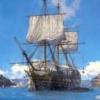
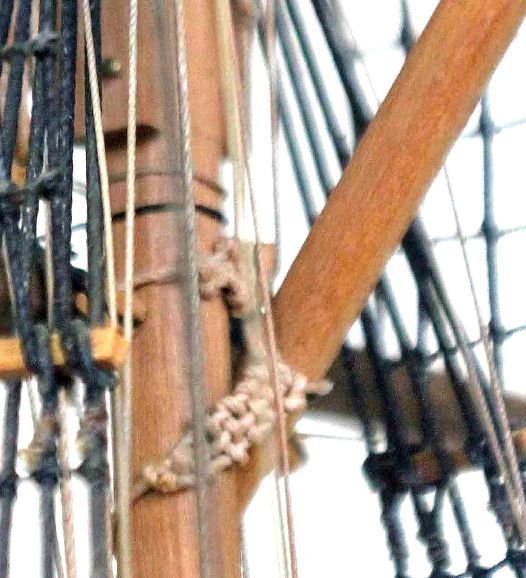
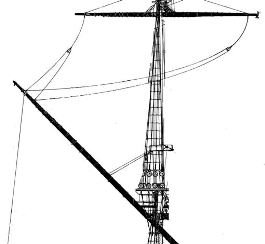

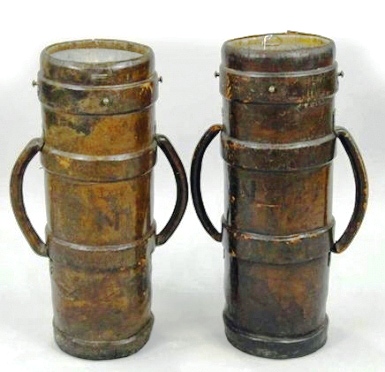
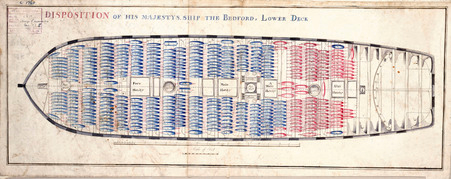
Royal William by ken3335 - FINISHED - Euromodel - Scale 1:72
in - Kit build logs for subjects built from 1751 - 1800
Posted
Hi Ken,
Mark alerted me to your build of the Royal William and I am delighted to now follow your progress. Your words are so refreshing to read and I know this is going to be another enjoyable experience for me (as well as for you). I have read everything you have done right from the start and everything looks as if the build is going to plan but did smile when you said you were going to keep this as a basic build. You could .... but you won't. Unlike other kits, the Euromodel drawings just draw you into thinking about what you are doing and so no two Royal William builds will ever be the same.
Good luck and remember the Euromodel helpdesk operates from opposite sides of the world on a 24/7 basis. But also there are a number of other great 'RW' builders out there with plenty of experience and ability. One way or another, help or advice is not far away.
Regards,
Pete